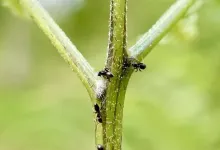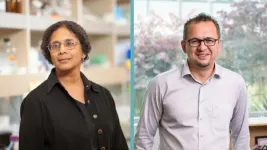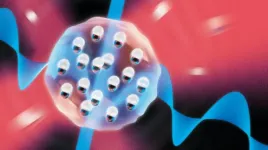(Press-News.org) Collaborations across research disciplines can lead to unexpected breakthroughs and discoveries. Collaborations across species lead to unexpected evolutionary paths of mutual benefit.
For example, some plants have managed to recruit ant bodyguards. They produce sugary nectar on their leaves that attracts the ants, then these very territorial and aggressive ant mercenaries patrol “their” plant and sting or bite herbivores that try to eat it.
These relationships are well-documented in flowering plants, but they also occur in non-flowering ferns. This is weird news for researchers, as it has long been thought that ferns lack the nectaries for such complex biotic interactions.
Jacob Suissa, assistant professor in the UT Department of Ecology and Evolutionary Biology, worked with colleagues at Cornell University, including fern expert Fay-Wei li and ant expert Corrie Moreau, to investigate how this phenomenon developed over the millennia. They recently published findings in Nature Communications about the evolutionary timeline and underlying factors of this interspecies partnership.
“The new elements of this work are twofold,” explained Suissa. “First, we discovered that nectaries—the structures that produce sugary nectar to attract ant bodyguards—evolved in ferns and flowering plants around the same time.”
This happened some 135 million years ago, coinciding with the rise of plant-ant associations in the Cretaceous period.
“This timing is quite spectacular given that it is very late in fern evolutionary history, nearly 200 million years after their origin,” said Suissa. “But it’s very early in flowering plant evolutionary history, nearly at the start of their origin in the Cretaceous.”
The second new element is how it all happened. Ferns originally flourished as terrestrial plants, growing on the forest floor. They transitioned in a major way in the Cenozoic Era, around 60 million years ago, becoming epiphytic, or tree dwelling, plants.
They learned some new habits on their way up.
“We discovered that as ferns left the forest floor and moved into the canopies, either as epiphytes, climbers, or tree ferns, they tapped into the existing ant-flowering plant interactions and evolved nectaries,” said Suissa.
This presents a curious dynamic in the ecological and evolutionary history of these two plant lineages. Ferns and flowering plants diverged from a common ancestor more than 400 million years ago, but then hit their stride in parallel with their nectary evolution and the mutually beneficial ant-plant tradeoff.
“This suggests that there may be some ‘rules of life’ governing the evolution of non-floral nectaries and ant-plant mutualism,” said Suissa. “This work can help future investigations by providing the evolutionary framework or backdrop for ecological, developmental, or genomic analyses.”
Read Suissa’s full paper, “Convergent evolution of nectaries in ferns facilitated the independent recruitment of ant-bodyguard from flowering plants,” in Nature Communications.
END
Suissa study has high hopes for plant-ant partnerships
2024-06-03
ELSE PRESS RELEASES FROM THIS DATE:
Zhu & Lee to study data-centric social bias mitigation
2024-06-03
Ziwei Zhu, Assistant Professor, Computer Science, and Jin Lee, Assistant Professor, Criminology, Law and Society, are set to receive funding for: “Data-Centric Social Bias Mitigation for Large Language Model-based Cyberharassment Detection.”
The researchers aim to address the critical challenge of algorithmic bias in Large Language Models (LLMs) used for cyberharassment detection.
They will focus on reducing unfair treatment against minority populations identified by gender, race, religion, sexual orientation, and disability.
Despite the ...
June issues of APA journals cover new research on autism, ADHD, schizophrenia and more
2024-06-03
WASHINGTON, D.C., June 3, 2024 — The latest issues of two American Psychiatric Association journals, The American Journal of Psychiatry and Psychiatric Services are now available online.
The June issue of The American Journal of Psychiatry features advances in understanding schizophrenia, ADHD, and autism spectrum disorder. Highlights include:
Long-Term Course of Remission and Recovery in Psychotic Disorders. (Lead author Sara Tramazzo is the featured guest on June’s AJP Audio podcast episode.)
The Genesis of Schizophrenia: An Origin Story
Recapitulation of Perturbed Striatal Gene Expression Dynamics of Donors’ ...
New machine learning method can better predict spine surgery outcomes
2024-06-03
Researchers who had been using Fitbit data to help predict surgical outcomes have a new method to more accurately gauge how patients may recover from spine surgery.
Using machine learning techniques developed at the AI for Health Institute at Washington University in St. Louis, Chenyang Lu, the Fullgraf Professor in the university’s McKelvey School of Engineering, collaborated with Jacob Greenberg, MD, assistant professor of neurosurgery at the School of Medicine, to develop a way to predict recovery more accurately from lumbar spine surgery.
The results published this month in the journal Proceedings of the ACM ...
LJI scientists develop new method to match genes to their molecular 'switches'
2024-06-03
LA JOLLA, CA—Scientists at La Jolla Institute for Immunology (LJI) have developed a new computational method for linking molecular marks on our DNA to gene activity. Their work may help researchers connect genes to the molecular "switches" that turn them on or off.
This research, published in Genome Biology, is an important step toward harnessing machine learning approaches to better understand links between gene expression and disease development.
"This research is about bringing a three-dimensional perspective to studying DNA modifications and their function in our genome," says LJI Associate Professor Ferhat Ay, Ph.D., who co-led the study with LJI ...
The coldest lab in New York has a new quantum offering
2024-06-03
There’s a hot new BEC in town that has nothing to do with bacon, egg, and cheese. You won’t find it at your local bodega, but in the coldest place in New York: the lab of Columbia physicist Sebastian Will, whose experimental group specializes in pushing atoms and molecules to temperatures just fractions of a degree above absolute zero.
Writing in Nature, the Will lab, supported by theoretical collaborator Tijs Karman at Radboud University in the Netherlands, has successfully created a unique quantum state of matter called a Bose-Einstein Condensate (BEC) out of molecules.
Their BEC, cooled ...
Altered carbon points toward sustainable manufacturing
2024-06-03
By Shawn Ballard
The recent spike in food prices isn’t just bad news for your grocery bill. It also impacts the sugars used in biomanufacturing, which, by the way, isn’t quite as green as scientists and climate advocates expected. Surging prices and increasing urgency for genuinely sustainable manufacturing has pushed researchers to explore alternative feedstocks.
Feng Jiao, the Elvera and William R. Stuckenberg Professor in in the McKelvey School of Engineering at Washington University in St. Louis, developed a two-step process to convert carbon dioxide ...
Telemedicine may increase endocrinology care access for under-resourced patients with diabetes and heart disease
2024-06-03
BOSTON—Widespread availability of telemedicine during the pandemic led to more equitable access to endocrinology care for patients with type 2 diabetes and heart disease, according to a study being presented Monday at ENDO 2024, the Endocrine Society’s annual meeting in Boston, Mass.
Patients who benefited included those living in rural areas and in neighborhoods with lower socioeconomic status, according to the study.
While most adults with type 2 diabetes receive care in the primary care setting, adults who have both type 2 diabetes and cardiovascular disease ...
Exploration of enzyme-polymer interactions is a crucial first step toward the development of next-gen degradable wound coverings
2024-06-03
Imagine you’re deep in the backcountry on a hiking trip, and you fall and rip a deep gash in your lower leg. You’re a two-day walk away from proper treatment. After you stop the bleeding, your concern becomes keeping the wound clean.
Now, imagine you had just the thing in your first aid kit—a spray-on bandage embedded with a mild painkiller and a disinfectant. A bandage meant to deliver relief, and degrade within 48 hours, giving you time to make it to the hospital.
That’s one reality that Whitney Blocher McTigue, an assistant professor ...
Pudukotai Dinakarrao receives funding for continuous and lightweight authentication for wearable and portable embedded systems
2024-06-03
Sai Manoj Pudukotai Dinakarrao, Assistant Professor, Electrical and Computer Engineering, received funding for the project: “CLAWS: Continuous and Lightweight Authentication for Wearable and Portable Embedded Systems.”
“The target of this funding is to accelerate the transition of technology,” Pudukotai Dinakarrao said.
Using this proposed authentication technique, Pudukotai Dinakarrao will collect the gait signal of a user continually using a lightweight always-on sensing methodology. The collected gait signal will be analyzed through resource-aware dynamic early-exit neural networks (EENets) for authentication.
The proposed technique ...
Most surface ozone contributing to premature mortality in European countries is imported
2024-06-03
Exposure to current levels of ground-level ozone (O3) in Europe is one of the main causes of premature mortality due to air pollution, especially in summer. A study led both by the Barcelona Institute for Global Health (ISGlobal), a centre supported by the "la Caixa" Foundation, in collaboration with the French National Institute of Health and Medical Research (Inserm), and the Barcelona Supercomputing Center - Centro Nacional de Supercomputación (BSC-CNS), has quantified for the first ...



